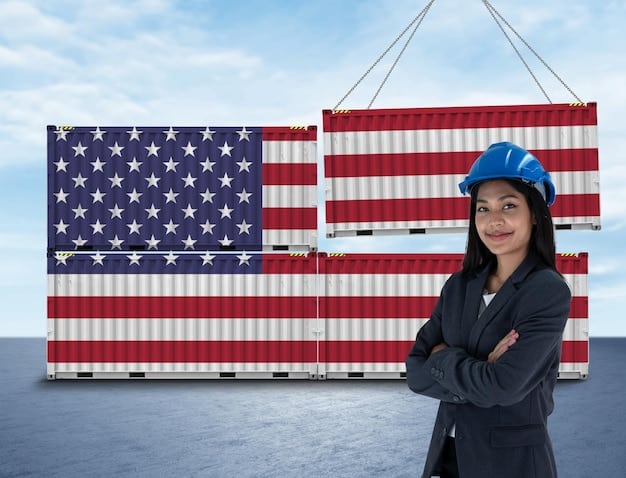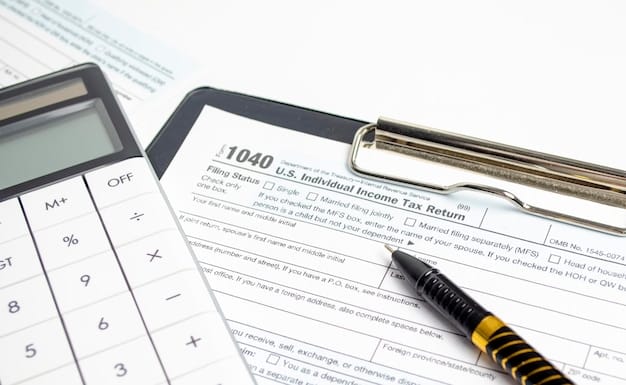The Ultimate Importer’s Guide to US Customs Valuation

Navigating US Customs valuation can be complex; this guide provides importers with essential strategies to accurately declare the value of goods, minimize duties, and avoid potential penalties, ensuring compliance and optimizing import costs.
Importing goods into the United States involves more than just finding the right products and suppliers. Understanding **the importer’s guide to US Customs Valuation: minimize duties and avoid penalties** is crucial for staying compliant and ensuring profitability.
Understanding US Customs Valuation
US Customs valuation is the process of determining the dutiable value of imported goods. This value is used to calculate the amount of import duties owed to the US government. Getting this right is essential for legal compliance and financial stability.
What is Dutiable Value?
The dutiable value is the price actually paid or payable for the goods when sold for export to the United States, plus certain additions. It’s not just the invoice price, and understanding what needs to be included is critical.
The Transaction Value Method
The primary method used by US Customs to determine the value of imported merchandise is the transaction value method. This is based on the price actually paid or payable for the goods, with certain adjustments.

For those using the transactional value method, here are key aspects to consider:
- Price Actually Paid or Payable: This is the direct cost for the goods.
- Additions to the Price: These can include packing costs, selling commissions, and the value of any assists.
- Deductions: Certain costs like international freight and insurance may be deductible under specific conditions.
Understanding the transaction value method is the first step in ensuring your customs valuation is accurate. Knowing what elements to include, and what can be deducted, can make a significant difference in the duties you pay.
Key Elements of Transaction Value
Transaction value is a cornerstone of US Customs valuation, but it involves several components that importers must understand to ensure accurate declarations. Failing to properly account for included costs can raise red flags for CBP.
Included Costs in Transaction Value
When determining the transaction value, US Customs requires importers to include specific costs beyond just the price of the goods. These included costs are often overlooked, which can lead to valuation errors.
Exclusions from Transaction Value
While many costs must be included, there are specific exclusions allowed by US Customs that can reduce the dutiable value. Understanding these exclusions can lead to significant savings.
Understanding the included and excluded costs can lead to reduced duties:
- Packing Costs: Costs for packing materials and labor to prepare the goods for shipment.
- Selling Commissions: Commissions paid by the buyer to an agent assisting in the purchase.
- Value of Assists: The value of goods or services provided by the buyer to the seller at a reduced or no cost.
Careful consideration of these elements and exclusions is key to properly valuing your imports.
The Role of Assists in Customs Valuation
Assists, as defined by US Customs, are goods or services provided by the buyer to the seller at a reduced or no cost, used in the production of imported merchandise. Accurately valuing assists is critical because they must be included in the customs value of the goods.
Types of Assists
Assists can take various forms, including materials, components, tools, dies, molds, or engineering work undertaken in the United States and sent abroad.
Valuing Assists
Determining the value of assists can be complex, as it is based on the cost of acquiring or producing the assist. This can involve allocating costs over the number of units produced.

Here are a few real-world examples to consider:
- Materials: Raw materials or components provided by the buyer.
- Tools: Molds and tooling used in the manufacturing process.
- Engineering Work: Design and engineering services provided by the buyer.
Properly identifying and valuing assists accurately is a key aspect of import compliance and can impact your duty calculations significantly. Failing to include assists can result in undervaluation, leading to penalties and other enforcement actions.
Alternative Valuation Methods
While the transaction value method is preferred, there are situations where it cannot be used. In these cases, US Customs allows the use of alternative valuation methods, applied in a specific order.
Identical or Similar Goods
If the transaction value cannot be determined, the customs value can be based on the transaction value of identical or similar goods sold for export to the United States.
Deductive Value Method
The deductive value method starts with the resale price of the imported goods in the United States, deducting certain expenses to arrive at the customs value.
When the transaction value method isn’t applicable, the fallback valuation strategies are:
- Computed Value Method: This method calculates the value using the cost of materials, fabrication, profit, and expenses.
- Fall-Back Method: If none of the other methods can be applied, a “reasonable means” is used.
- Method Application: Understanding the order of application for these methods is crucial for compliance.
Ensuring that you understand these methods will ensure that you can assign an appropriate declared value when importing goods into the United States.
Minimizing Duties Through Strategic Valuation
Strategic valuation involves legally optimizing the declared value of imported goods to minimize duty payments. This requires a deep understanding of US Customs regulations and careful planning.
Understanding Dutiable vs. Non-Dutiable Charges
Certain charges, such as international freight and insurance, may be non-dutiable under specific circumstances. Properly identifying these charges can reduce the dutiable value.
Utilizing Free Trade Agreements
The United States has free trade agreements (FTAs) with many countries. These agreements often provide for reduced or eliminated duty rates, provided the goods meet specific origin requirements.
Minimizing duties requires a strategic approach:
- Reviewing Invoices: Ensure that all charges are accurately described and allocated.
- Seeking Expert Advice: Engaging a customs broker or consultant can provide valuable guidance.
- Maintaining Accurate Records: Proper record-keeping is essential for supporting valuation decisions.
Strategic valuation requires proactive analysis, detailed documentation and expert advice. By legally optimizing your declared value, you will minimize what you’re paying, improve cash flow and increase profit margins, allowing you to be more competitive.
Avoiding Penalties: Compliance Best Practices
Compliance with US Customs valuation rules is essential to avoid penalties, fines, and other enforcement actions. Implementing best practices can help importers maintain compliance.
Record Keeping Requirements
US Customs requires importers to maintain detailed records related to their imports for a period of five years. These records must be readily available for inspection upon request.
Seeking Professional Guidance
Engaging a licensed customs broker or consultant can provide valuable expertise and assistance in navigating the complexities of US Customs valuation.
Compliance is crucial to avoiding penalties:
- Staying Informed: Regularly update your knowledge of customs regulations.
- Conducting Internal Audits: Periodically review your import documentation.
- Cooperating with Customs: Fully cooperate with US Customs during audits and investigations.
Adhering to compliance best practices allows for greater legal certainty, allowing you to avoid penalties and legal issues.
| Key Point | Brief Description |
|---|---|
| 💰 Transaction Value | Price paid or payable, plus certain additions like packing costs. |
| 📦 Assists | Goods/services provided by the buyer to the seller at reduced cost. |
| ⚖️ Alternative Methods | Used when transaction value isn’t applicable; includes deductive value. |
| 📝 Compliance | Maintain accurate records and seek professional advice for customs valuation. |
Frequently Asked Questions
▼
US Customs Valuation is the process of determining the dutiable value of imported goods, used to calculate import duties owed to the US government.
▼
Transaction Value is the price actually paid or payable for the goods when sold for export to the US, plus certain additions like packing costs.
▼
Assists are goods/services provided by the buyer to the seller at reduced/no cost, used in production. They must be included in customs value.
▼
By fully understanding what’s dutiable versus non-dutiable and strategically utilizing Free Trade Agreements where applicable.
▼
Compliance prevents penalties, and maintains an important understanding of customs regulations through detailed record-keeping.
Conclusion
Mastering US Customs valuation is essential for any importer looking to succeed in the US market. By understanding the rules, utilizing strategic valuation techniques, and prioritizing compliance, you can minimize duties, avoid penalties, and maintain a competitive edge in today’s global marketplace.





